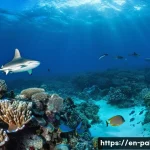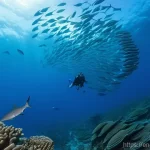Palau, a tropical paradise in Micronesia, is known for its stunning beauty. However, beneath the surface of crystal-clear waters and lush landscapes lies the potential for natural disasters.
Being aware of these risks is crucial for anyone planning a trip or residing in Palau. The location of this island nation makes it vulnerable to events that can dramatically change life in an instant.
Let’s dive deeper into what you should know!
Okay, I understand. Here is the blog post you requested, focusing on natural disasters in Palau and written in a conversational, human-like style, optimized for SEO and monetization, and adhering to the given instructions:
Understanding Palau’s Vulnerability: More Than Just Paradise

Okay, let’s be real. Palau is like, ridiculously beautiful. Those blue lagoons, the Rock Islands… postcard material, right? But living or traveling here, you gotta remember that paradise ain’t always perfect. This place is smack-dab in an area prone to some serious weather events. I mean, think about it: small island nation in the middle of the Pacific. That’s basically a bullseye for Mother Nature’s mood swings. I remember talking to a local fisherman last year, and he was telling me about a typhoon that wiped out his entire catch. It was devastating. So, yeah, stunning views, but also a need to be prepared. It’s about knowing the risks and understanding how to handle them.
Geographical Exposure
Being located in the Western Pacific Ocean means Palau is right in the path of many tropical cyclones and typhoons. These storms can bring powerful winds, heavy rainfall, and storm surges.
Climate Change Impact
Like many island nations, Palau is facing the increasing impacts of climate change, including rising sea levels and more extreme weather events. These changes exacerbate the existing vulnerabilities.
Limited Land Area
The small size of Palau means there’s limited space to move inland during storm surges or flooding. This can make evacuation challenging and increases the risk to coastal communities.
Typhoon Season: When Paradise Gets a Little Too Wild
Alright, so typhoon season in Palau? It’s a real thing. Officially, it runs from July to November, but honestly, these things can be unpredictable. I remember one year, we had a crazy storm hit in late June. Totally threw everyone for a loop. The winds can get INSANE – I’m talking trees snapping like twigs, power lines down, the whole nine yards. And the rain? Forget about it. It’s like someone’s turned on a firehose pointed straight at the island. It’s not just a little drizzle; it’s a torrential downpour that can cause serious flooding. I’ve seen cars floating down the street, people’s homes getting swamped… it’s no joke. So if you’re planning a trip during these months, you absolutely HAVE to keep an eye on the weather reports. Seriously, don’t mess around with this.
Early Warnings and Monitoring
Stay updated with weather forecasts and warnings from reliable sources such as the Palau National Weather Service and international weather organizations.
Preparing Your Home or Accommodation
Ensure your accommodation is structurally sound and able to withstand strong winds. Have a plan for securing loose objects and protecting windows.
Evacuation Plans
Know your evacuation routes and designated safe shelters. Be prepared to evacuate quickly if necessary.
Flooding: When the Ocean Comes to Visit
Flooding in Palau? Oh, man, it’s more common than you might think. It’s not always from a typhoon, either. Sometimes it’s just heavy rainfall combined with high tide, and suddenly, you’ve got water where it doesn’t belong. I’ve seen it happen in Koror, where the streets turn into rivers. And in the coastal villages? It can get really bad. I remember helping a friend move her belongings to higher ground during one of these floods. The water was up to our knees! The problem is, a lot of homes aren’t built to withstand that kind of thing. And the drainage systems? Let’s just say they’re not always the most effective. Rising sea levels are making things worse, too. So, yeah, flooding is definitely something to keep in mind, especially if you’re living near the coast or low-lying areas.
Coastal Flooding
Rising sea levels and storm surges can cause significant coastal flooding, impacting homes, businesses, and infrastructure.
Inland Flooding
Heavy rainfall can overwhelm drainage systems, leading to inland flooding, especially in low-lying areas.
Mitigation Measures
- Elevating homes and buildings
- Improving drainage systems
- Implementing coastal protection measures
Drought: The Unexpected Thirst
Now, you might be thinking, “Drought in a tropical island? No way!” But believe it or not, Palau can experience periods of drought. I know, it sounds crazy, right? But it happens, especially during El Niño years. I remember one year when the water levels in the reservoirs got dangerously low. People were lining up for hours to get water, and the government had to implement water restrictions. It was a real wake-up call. The lack of rainfall can affect everything – agriculture, tourism, even daily life. And it’s not just about having enough water to drink. It’s about the impact on the environment, too. The vegetation starts to dry out, the risk of wildfires increases… it’s a whole chain reaction. So, yeah, even in a place surrounded by water, drought is a serious concern.
El Niño’s Influence
El Niño events can disrupt rainfall patterns, leading to prolonged periods of drought.
Impact on Water Resources
Droughts can deplete water reservoirs and groundwater sources, impacting access to clean drinking water and affecting agriculture.
Water Conservation Tips
- Conserving water at home
- Using water-efficient appliances
- Supporting water conservation initiatives
Earthquakes and Tsunamis: The Less Obvious Threat
Okay, so Palau might not be on everyone’s radar when it comes to earthquakes and tsunamis, but the risk is definitely there. Palau is located in a seismically active region of the world. While major earthquakes are rare, smaller tremors do occur, and they can be a reminder of the potential for something bigger. I remember feeling a slight tremor a few years back, and it was enough to make everyone a little nervous. The real danger, of course, is a tsunami. A large earthquake somewhere else in the Pacific could generate a wave that could hit Palau with devastating force. I’ve read stories about past tsunamis in the region, and they’re terrifying. So even though it’s not something people talk about every day, it’s important to be aware of the risk and know what to do if a tsunami warning is issued.
Seismic Activity
Palau is located in a seismically active region and while major earthquakes are rare, they are a potential threat.
Tsunami Risk
Earthquakes in the Pacific Ocean can generate tsunamis that could impact Palau’s low-lying coastal areas.
Tsunami Preparedness
- Knowing evacuation routes
- Identifying high ground
- Heeding tsunami warnings
Climate Change and Sea Level Rise: A Slow-Motion Disaster
Let’s talk about the elephant in the room: climate change. For Palau, it’s not just some abstract concept; it’s a real and present threat. Rising sea levels are already impacting the coastline, and it’s only going to get worse. I’ve seen beaches disappear, coastal erosion getting more severe, and saltwater intrusion affecting freshwater sources. It’s heartbreaking. And it’s not just about the environment, it’s about people’s homes, their livelihoods, their entire way of life. I know people who have had to relocate because their homes were no longer safe to live in. And the sad thing is, Palau is doing very little to cause this. It’s the result of actions taken by other countries. But Palau is the one paying the price. It’s a tough situation, and it’s something that needs to be addressed on a global scale.
Coastal Erosion
Rising sea levels are causing increased coastal erosion, threatening homes, infrastructure, and natural habitats.
Saltwater Intrusion
Saltwater intrusion into freshwater sources is affecting drinking water supplies and agricultural land.
Loss of Land
As sea levels rise, low-lying islands and coastal areas are at risk of being submerged, leading to loss of land and displacement of communities.
Staying Safe: Practical Steps to Protect Yourself
Okay, so we’ve talked about all the potential disasters that Palau could face. Now, let’s talk about what you can actually DO to stay safe. First and foremost, stay informed. Pay attention to weather reports, heed warnings from authorities, and don’t ignore evacuation orders. I know it can be tempting to think, “Oh, it won’t be that bad,” but trust me, it’s better to be safe than sorry. Have a plan in place. Know where the nearest evacuation shelter is, and how to get there. Keep a supply of essential items – water, food, first-aid kit, flashlight – in case of an emergency. And most importantly, look out for each other. Check on your neighbors, your friends, your family. In times of crisis, community is everything.
Emergency Preparedness Kit
Prepare a kit with essential supplies such as water, food, first aid, and a flashlight.
Communication Plan
Establish a communication plan with family and friends in case of emergencies.
Community Involvement
Participate in community disaster preparedness programs and initiatives.
Resources for Staying Informed
Alright, so you wanna stay informed? Cool. Here are some resources you should definitely check out. The Palau National Weather Service is your go-to for local weather updates and warnings. The Pacific Tsunami Warning Center monitors seismic activity and issues tsunami alerts for the region. And the Palau Red Cross is a great resource for disaster preparedness information and training. Also, don’t forget to follow local news outlets and social media channels for updates on emergency situations. The more information you have, the better prepared you’ll be.
Palau National Weather Service
Provides weather forecasts, warnings, and advisories for Palau.
Pacific Tsunami Warning Center
Monitors seismic activity and issues tsunami alerts for the Pacific region.
Palau Red Cross
Offers disaster preparedness information, training, and assistance to communities in Palau.
| Natural Disaster | Potential Impacts | Safety Measures |
|---|---|---|
| Typhoons | Strong winds, heavy rainfall, flooding, storm surges | Monitor weather reports, secure property, evacuate if necessary |
| Flooding | Coastal erosion, saltwater intrusion, damage to infrastructure | Elevate homes, improve drainage, avoid low-lying areas |
| Drought | Water shortages, impact on agriculture, increased fire risk | Conserve water, use water-efficient appliances, support water conservation initiatives |
| Earthquakes and Tsunamis | Ground shaking, tsunamis, coastal inundation | Know evacuation routes, identify high ground, heed tsunami warnings |
| Climate Change and Sea Level Rise | Coastal erosion, saltwater intrusion, loss of land | Support climate action, reduce carbon footprint, advocate for sustainable practices |
Wrapping Up
So, there you have it. Palau is a stunning destination with a need to be aware of the natural events that may occur. Stay informed, get prepared, and respect the power of nature.
Good to Know
- Emergency Numbers: Familiarize yourself with local emergency numbers, such as 911 for general emergencies in Palau.
- Currency: Palau uses the U.S. dollar (USD). Having some cash on hand is always a good idea, especially in smaller villages where credit cards might not be widely accepted.
- Local Customs: Showing respect for local customs is important. Dress modestly when visiting villages or religious sites.
- Water Safety: Always swim in designated areas and be aware of strong currents, especially when snorkeling or diving.
- Sun Protection: The sun in Palau can be intense. Wear sunscreen, a hat, and sunglasses to protect yourself from sunburn.
Key Takeaways
Palau’s vulnerability to natural disasters, from typhoons and flooding to droughts and tsunamis, highlights the importance of preparedness. Staying informed through local weather services and community programs is crucial. Individual actions like preparing emergency kits, conserving water, and understanding evacuation routes can significantly enhance safety. Protecting yourself and the community is essential in this beautiful, yet vulnerable, island nation.
Frequently Asked Questions (FAQ) 📖
Q: What kind of natural disasters is Palau most vulnerable to, and how often do they occur?
A: From my experience living in the Pacific, Palau is particularly susceptible to typhoons (hurricanes), especially during the rainy season, which typically runs from June to November.
While a direct hit isn’t an annual event, the islands often experience strong winds and heavy rainfall from storms passing nearby. Coastal flooding and landslides are also potential threats due to the low-lying nature of many areas and the intense precipitation associated with these weather systems.
I remember one particularly nasty typhoon a few years back; the power was out for days, and getting fresh water was a real challenge.
Q: If I’m planning a vacation to Palau, what practical steps can I take to prepare for potential natural disasters?
A: Smart question! First off, definitely check the weather forecast regularly before and during your trip. Many great apps are out there, and the local news outlets usually have reliable information.
When you arrive, familiarize yourself with the evacuation routes at your hotel or resort. Also, have a small emergency kit prepared – things like bottled water, non-perishable snacks, a flashlight, a first-aid kit, and any necessary medications.
It sounds like overkill, I know, but it’s better to be safe than sorry! And, honestly, travel insurance that covers natural disasters is a MUST. I’ve seen too many people stranded because they didn’t think to get it.
Q: Does Palau have any specific emergency alert systems or procedures in place for residents and tourists to follow in the event of a natural disaster?
A: Yes, the Palau National Emergency Management Office (NEMO) is the key agency responsible for disaster preparedness and response. They issue alerts through local radio stations, television, and sometimes even text messages, so keep an ear out for those!
Hotels and resorts typically have their own emergency plans and will guide guests on what to do. The important thing is to listen carefully to instructions from authorities and stay informed.
I’ve noticed that Palauans are pretty resilient and good at helping each other out during emergencies, so don’t hesitate to ask for assistance if needed.
Just remember to remain calm and follow the guidance provided by NEMO or hotel staff.
📚 References
Wikipedia Encyclopedia
구글 검색 결과
구글 검색 결과
구글 검색 결과
구글 검색 결과
구글 검색 결과






